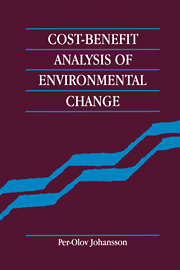Book contents
- Frontmatter
- Contents
- List of figures
- Preface
- 1 Introduction
- 2 Some basic concepts
- 3 Consumer surplus measures
- 4 Valuing public goods: practical methodologies
- 5 General equilibrium cost-benefit rules
- 6 Cost-benefit rules, national income accounts and sustainable development
- 7 Valuation and aggregation: intragenerational and intergenerational issues
- 8 Cost-benefit rules in a risky world
- 9 Valuing changes in access conditions, health risks and information
- 10 Empirical applications
- 11 Policy instruments and international environmental problems
- Notes
- References
- Index
10 - Empirical applications
Published online by Cambridge University Press: 15 January 2010
- Frontmatter
- Contents
- List of figures
- Preface
- 1 Introduction
- 2 Some basic concepts
- 3 Consumer surplus measures
- 4 Valuing public goods: practical methodologies
- 5 General equilibrium cost-benefit rules
- 6 Cost-benefit rules, national income accounts and sustainable development
- 7 Valuation and aggregation: intragenerational and intergenerational issues
- 8 Cost-benefit rules in a risky world
- 9 Valuing changes in access conditions, health risks and information
- 10 Empirical applications
- 11 Policy instruments and international environmental problems
- Notes
- References
- Index
Summary
Unfortunately, there seem to be few, if any, cost-benefit analyses of environmental changes that strictly follow the project evaluation rules derived in previous chapters. Others are presented so sketchily that it is impossible to infer what rules have been used. Nevertheless, in this chapter a few empirical studies are summarized. The first two studies are both based on the contingent valuation method, one using continuous responses, the other using both continuous and binary responses. A study explicitly introducing risk is then presented. The possibility of using computable general equilibrium models is highlighted by summarizing a CGE-based evaluation of environmental regulations. A study by Hammack and Brown (1974) illustrates how optimal control theory and simulation models can be employed in evaluations. Finally an attempt to account for natural resource depletion in national accounts is discussed.
A cost-benefit analysis of land reclamation
Michael and Pearce (1989) assessed the benefits and costs of land reclamation at Higher Folds in the UK. Prior to reclamation, which began in 1977, this 191 hectare site included a prominent plateau of colliery spoil heaps up to 25 metres high, some of which loomed over houses on the Higher Folds housing estate and collapsed into back gardens. The spoil heaps frequently caught fire, causing problems of nuisance from smoke and unpleasant sulphurous smells, and dust blew from the site in dry weather. The site also contained fourteen mine shafts, dangerous subsidence flashes and lagoons, derelict buildings, disused railway lines, a station and sidings and a former sewage works. Owing to the high acidity of the colliery spoil, vegetation was slow to colonize the site.
- Type
- Chapter
- Information
- Cost-Benefit Analysis of Environmental Change , pp. 178 - 199Publisher: Cambridge University PressPrint publication year: 1993
- 1
- Cited by



